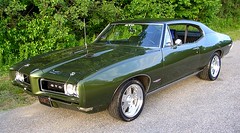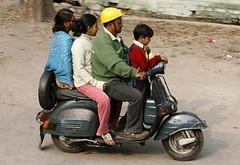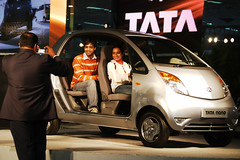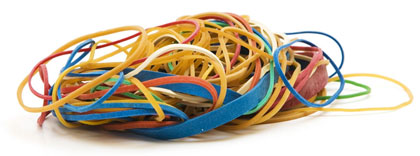What is the value of owning a car? What benefits do 4 wheels and a roof offer to the driver? As someone who lives in Chicago and commutes every day – on a morning like this when it is 15 degrees Fahrenheit outside, the immediate answer is safe, efficient, dry and especially warm transportation. Safety comes first in my mind because when it comes right down to it, a car is the box on wheels that protects the cargo – you and your family – when an accident happens.
Would you believe though that owning a car rather than say a motorcycle could improve your social standing and increase your marriage prospects? In America where we worship our cars it would seem odd to consider that car ownership bestows that kind of value but why else do young men lust after a high powered 1968 Nightshade Green GTO hardtop or a sleek BMW convertible or a massive jacked-up Ford F-150 truck with large knobby tires? To be cool and impress the girls, of course. Cars are all about status. One just had to stroll the aisles of the Chicago Auto Show which wrapped up 10 days ago to see what the auto manufacturers were selling: power, prestige, thrills, excitement with the appropriate amounts of safety and convenience peppered in as well. For some young men, their car defines them – it symbolizes their freedom, their power, their virility, their style.

In an earlier post I examined Dr. Paul Polak’s focus of designing for the other 90 percent of the world. By the other 90 percent he of course means focusing innovation efforts on helping improve the lives of those who scratch to survive each day by improving their access to food and water, energy, education, healthcare, revenue generating activities, and affordable transportation.
Tata Motors has focused on delivering that last benefit – transportation – to the masses in India and perhaps to the world. On January 15th, the largest auto manufacturer in India unveiled their rumored $2500 car (or 100,000 rupees), the Nano. It may not have been unveiled at the Detroit Auto Show but it instantly became the talk of that show. Tata drew a line in the sand and declared that they were prepared to pursue the very low end of the market, the consumers who today cannot afford an automobile but instead make do with a motor scooter or if they are lucky a 3 wheel rickshaw.

The Chairman, Ratan N. Tata described his personal inspiration for the car:
I observed families riding on two-wheelers – the father driving the scooter, his young kid standing in front of him, his wife seated behind him holding a little baby. It led me to wonder whether one could conceive of a safe, affordable, all-weather form of transport for such a family. Tata Motors’ engineers and designers gave their all for about four years to realise this goal. Today, we indeed have a People’s Car, which is affordable and yet built to meet safety requirements and emission norms, to be fuel efficient and low on emissions. We are happy to present the People’s Car to India and we hope it brings the joy, pride and utility of owning a car to many families who need personal mobility.

He doesn’t go into the full details though of what it means to own a four wheel rather than a 2 or 3 wheel vehicle in the Indian villages. Of all things, owning a 4 wheel vehicle increases the marriage prospects and perception of success of the man/family who owns it. An excellent Forbes article describes the work of the project manager who oversaw the development of the Nano, Girish Wagh, and what he learned in his earlier efforts to develop a truck that would compete with the 3 wheeled motorized rickshaws that many farmers use. By doing something no one had ever done at Tata – talk to customers – he finally found the key insight. As the article explains:
In 2000, Ravi Kant, Managing Director of Tata Motors, needed someone to take on a risky project–to extend the truck line beyond the sturdy Tata mainstays. Kant wanted one cheap enough to compete with three-wheeled, motorized rickshaws and even considered building a small, three-wheeled truck.
Before starting the project, Wagh did something no one at Tata Motors ever had: He talked to customers. The three-wheeler men inevitably insisted on a cheap, dependable truck that could go from village to market carrying, say, 200 chickens, a ton of onions or potatoes, or 2,000 eggs. One night, as sunset approached, Wagh stuck with one rickshaw driver. “I kept asking the question. Why? Why? Why do you want a four-wheeler?” Wagh remembered. Finally, he got the real answer. It turned out it wasn’t really a problem of chickens or eggs. “If I had a four-wheeler, I would have better marriage prospects in my village,” the young man said. Drivers of three-wheelers are looked down upon in India. Wagh realized that four wheels had emotional, not just practical, appeal.
When Tata Motors brought out the bare-bones Ace truck in May 2005 for just $5,100, it had a monster hit: The company sold 100,000 in 20 months. To try to keep up with demand, it offers the truck only in white to save the time it takes to change colors in the factory paint shop. Tata is building a new factory that will be able to turn out 250,000 a year starting this month.
So when Tata Motors needed someone to take charge of the company’s most ambitious plan yet–to build the world’s cheapest car ever–Ravi Kant, who by then had become the company’s managing director, again turned to Wagh. Wagh remembers what he learned marketing the little truck. “People want to move from two-wheelers to four-wheelers,” he says. “Today they can’t afford it.”
Drivers of 3 wheelers are looked down upon in India which means that people want to move from 2 or 3 wheel to 4 wheel vehicles and today they can’t afford it. Two wheeled scooters and motorcycles sell for $675 to $1600 and the per capita annual income is ~$800. So this begins to make it feasible for millions of people in India and other developing countries to own a car.

Now I’m not going to go into the contentious side of this question because there really are significant concerns with adding more cars to the already crowded streets in India or any country for that matter. Increased petrol dependency, increased consumption of a dwindling resource, and let’s not forget about air quality and the ozone layer. All kinds of people are coming out of the woodwork to say what a bad precedent this is likely to create. Because every car manufacturer out there is studying this little car very closely. It wouldn’t pass emissions tests today in the United States or Europe. And it isn’t exactly a safe vehicle but when compared to the alternative (four on a scooter) or an open rickshaw it actually performs quite well in the safety category. But it does bring inexpensive, reliable, and comfortable transportation within the reach of millions of people who otherwise would literally be left out in the rain. Is it the right answer? Hard to say, but it is a brilliant example of one company’s focus on improving the prospects and lives of very low income people in a developing country.
And let’s not forget, that this is the same company that was announced by Ford Motors as the leading bidder for the Jaguar and Land Rover brands and production facilities. So in one month, a big little company in India jumped out on the world stage and put the luxury and the economy car manufacturers on notice that they are planning to make a VERY big splash in the world automotive pond.






